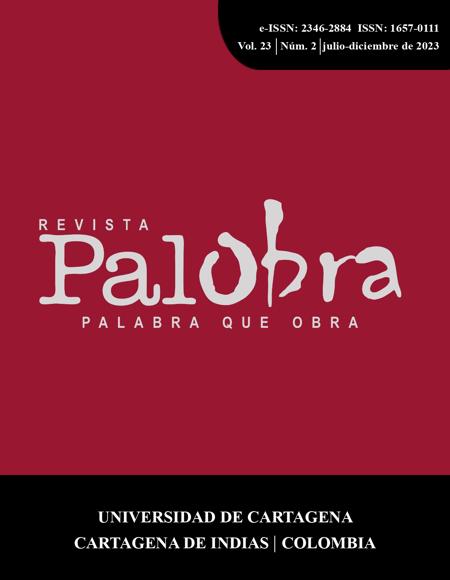Visualidad de la ausencia: Sentir la ruptura de la comunidad a través de la transportación retórica
Visuality of Absence: Sensing a Community’s Rupture Through Rhetorical Transport
Contenido principal del artículo
Resumen
Este artículo analiza el trabajo fotográfico Silencios de Juan Manuel Echavarría como una pieza de la cultura visual producida en los últimos años para representar y conmemorar la guerra en Colombia. Se aborda el concepto de transportación retórica propuesto por Michele Kennerly para describir el poder de estas imágenes para traer ante los ojos y la mente del espectador personas, lugares o cosas que están ausentes. Estas imágenes no logran presentar espacios vacíos y silenciosos ya que es inviable verlos sin la presencia de cuerpos. La quietud e inmovilidad que transmiten son interrumpidas por el espectador, quien llena esos espacios de vacío con voces, sonidos y movimientos. En estas imágenes, el poder retórico de condensar simultáneamente lo presente y lo ausente ofrece experiencias sensoriales opuestas.
Palabras clave:
Descargas
Detalles del artículo
Referencias (VER)
Ahmed, S. (2004). Affective Economies. Social Text 22(2), 117-139.
Barthes, R. (1986). The Rustle of Language. New York, NY: Hill and Wang.
Bello, M.N. (2013). Presentation. In National Center for Historical Memory. ¡Basta Ya! Colombia: Memorias de Guerra y dignidad (pp. 19-28). Bogotá: Imprenta Nacional.
Bonilla, J.I. (2018). El reflejo de Medusa. Fotografía, política de la imagen y barbarie en Colombia [Tesis Doctoral, Universidad Nacional de Colombia]. https://repositorio.unal.edu.co/handle/unal/64142
Brock, B. L., Scott, R. L., & Chesebro, J. W. (Eds.). (1990). Methods of rhetorical criticism: A twentieth-century perspective. Detroit, MI: Wayne State University Press. 3rd edition.
Carey, J. W. (1992). Communication as culture: Essays on media and society. Routledge.
Chernick, M. (1999). La negociación de una paz entre múltiples formas de violencia. In
F. Leal Buitrago (Ed.), Los laberintos de la guerra: Utopías e incertidumbres sobre la paz. (pp. 3-57). TM Editores.
Cloud, D. (2004). “To veil the threat of terror”: Afghan women and the in the Imagery of the U.S. War on Terrorism. Quarterly Journal of Speech, 90(3), 285–306. https://doi.org/10.1080/0033563042000270726
DeLyser, D. (1999). Authenticity on the ground: Engaging the past in a California ghost town. Annals of the Association of American Geographers, 89(4), 602-632. https://www.jstor.org/stable/2564461
Dickinson, G. (2020). Space, Place, and the Textures of Rhetorical Criticism. Western Journal of Communication, 84(3), 297–313. https://doi.org/10.1080/10570314.2019.1672886
Echavarría, J.M. (2018). Works. Paris: Toluca Éditions.
Finnegan, C. A., & Kang, J. (2004). “Sighting” the public: Iconoclasm and public sphere theory. Quarterly Journal of Speech, 90(4), 377–402. https://doi.org/10.1080/0033563042000302153
Finnegan, C. A., & Jones, J. L. (2006). Visualizing public address. Rhetoric & Public Affairs, 9(3), 489-505. https://www.jstor.org/stable/41940091
Foss, K. A., & Domenici, K.L. (2001). Haunting Argentina: Synecdoche in the Protests of the Mothers of the Plaza de Mayo. Quarterly Journal of Speech, 17, 237-258. https://doi.org/10.1080/00335630109384335
Gallagher, V.J., & Zagacki, K. (2005). Visibility and rhetoric: The power of visual images in Norman Rockwell´s depictions of civil rights. Quarterly Journal of Speech, 91, 175-200. https://doi.org/10.1080/00335630500291448
Giraldo, E. (2008). La letra con sangre. Jesús Abad Colorado. Revista Universidad de Antioquia, 294, 58-63. https://revistas.udea.edu.co/index.php/revistaudea/article/view/180
Hariman, R., & Lucaites, J. (2002). Performing civic identity: The iconic photograph of the flag raising at Iwo Jima. Quarterly Journal of Speech, 88, 363-392. https://doi.org/10.1080/00335630209384385
Hariman, R., & Lucaites, J. (2003). Public identity and collective memory in U.S. iconic photography: The image of “accidental Napalm.” Critical Studies in Media Communication, 20(1), 35-66. https://doi.org/10.1080/0739318032000067074
Harold, C., & DeLuca, K. (2005). Behold the corpse: Violent images and the case of Emmett Till. Quarterly Journal of Speech, 8, 263-286. https://www.jstor.org/stable/41939982
Hatfield, K. L. (2008). Communication Research: Falling towers, emerging iconography: A rhetorical analysis of Twin Tower images after 9/11. Texas Speech Communication Journal, 33(1), 62-73.
Jacksh, H. (2013). The empty chair is not so empty: Ghosts and the performance of memory in post-Katrina New Orleans. TDR/The Drama Review, 57(1), 102-115. https://doi.org/10.1162/DRAM_a_00237
Kennerly, M. (2010). Getting Carried Away: How Rhetorical Transport Gets Judgment Going. Rhetoric Society Quarterly, 40(3), 269-291. https://www.jstor.org/stable/27862446
Lara Ramos, D. (2015, October 22). En Las Palmas los dolores se alivian con tutelas. La Silla Vacía. https://www.lasillavacia.com/red-de-expertos/red-caribe/en-las-palmas-los-dolores-se-alivian-con-tutelas/
Lefebvre, H. (1991). The production of space. Blackwell.
Masacre de Las Palmas, Bolívar. (2019, October 15). Rutas del Conflicto. https://rutasdelconflicto.com/masacres/las-palmas-bolivar
Mason, A. (2003). Colombia’s Democratic Security Agenda: Public Order in the Security Tripod. Security Dialogue, 34, 391-409. https://doi.org/10.1177/0967010603344002
Medina, C. (1990). Autodefensas, paramilitares y narcotráfico en Colombia. Origen, desarrollo y consolidación. El caso Puerto Boyacá. Editorial de Documentos Jurídicos.
Melo, J.O. (2017). Historia mínima de Colombia. Turner Publicaciones.
Palabras de Francisco de Roux, presidente de la Comisión de la Verdad, ante el Consejo de Seguridad de la ONU. (2022, June 28). Comisión de la Verdad. https://comisiondelaverdad.co/
Recorridos por los paisajes de la violencia: Montes de María. (2018). Centro Nacional de Memoria Histórica. https://www.centrodememoriahistorica.gov.co/micrositios/recorridos-por-paisajes-de-la-violencia/index.html
Rubiano, E. (2017a). “Réquiem NN”, de Juan Manuel Echavarría: entre lo evidente, lo sugestivo y lo reprimido.” Cuadernos de Música, Artes Visuales y Artes Escénicas, 12(1),33–45.
Ospina, W. (1997). ¿Dónde está la franja amarilla? Bogotá: Norma.
Salcedo, R. (2009, July 22). A village that survived a massacre liven up with bagpipes. Retrieved from https://www.soho.co
Salcedo, R. (2012, October 2). Wikdiʼs journey. Soho. Retrieved from https://www.soho.co
Sánchez, G. (2013). Preface. In National Center for Historical Memory. ¡Basta Ya! Colombia: Memorias de Guerra y dignidad (pp. 13-16). Bogotá: Imprenta Nacional.
Sontag, S. (2002, December). Looking at war: Photography´s view of devastation and Death. The New Yorker Magazine, 9, 82-98. https://www.newyorker.com/magazine/2002/12/09/looking-at-war
Sontag, S. (1996). On Photography. Picador.
Stormer, N. (2004). Articulation: A working paper on rhetoric and taxis. Quarterly Journal of Speech, 90, 257–284. https://doi.org/10.1080/0033563042000255516
Uribe de Hincapié, M.T. (2004). Las palabras de la guerra. Estudios Políticos, 25, 11-34. https://revistas.udea.edu.co/index.php/estudiospoliticos/article/view/1397



 PDF
PDF
 FLIP
FLIP




